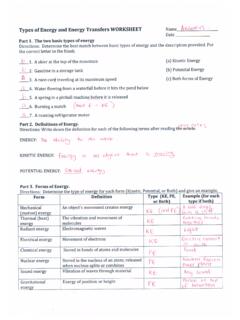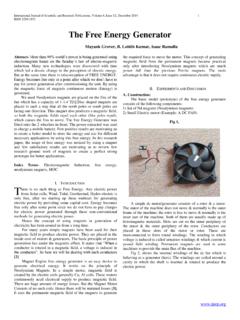Transcription of R.E.A.C.T. - Renewable Energy Activities - Choices for ...
1 Energy Activities Choices for TomorrowTeacher s Activity Guide forMiddle Level Grades 6-8 National Renewable Energy LaboratoryEducation Programs1617 Cole , Colorado 80401 Tel: (303) 275-3044 Home page: Education Office at nrel would like to thank Dr. James Schreck, Professor of Chemistry andBiochemistry, University of Northern Colorado, for his commitment and hard work in the developmentof this activity booklet. His expertise was invaluable in producing a final product that attempts to be"user friendly."It is the goal of the Education Office to make these kits accessible, easy to use, and fun. We want yourstudents to gain, not only an understanding of Renewable and nonrenewable Energy resources, but agreater confidence in investigating, questioning, and experimenting with scientific you have questions, please call the Education Office at (303) 275-3044 or Page 1TO THE EDUCATORThis activity booklet was developed by the Education Office at the National Renewable EnergyLaboratory.
2 Users of this booklet should practice appropriate safety guidelines in doingdemonstrations or hands-on CONTENT STANDARDSThe Activities in this booklet address portions of the following guidelines from the ColoradoScience Students understand the processes of scientific investigation, and design, conduct,communicate about, and evaluate such Physical Science: Students know and understand commonproperties, forms, and changes in matter and Energy . (Focus: Physicsand Chemistry) Students know that Energy appears in different forms, and can move (betransferred) and change (be transformed). Students understand that interactions can produce changes in a system, althoughthe total quantities of matter and Energy remain Students know and understand interrelationships of matter and Energy in Students know and understand interrelationships among science, technology, andhuman activity and how they can affect the are encouraged to use task assessments that will meet the individual needs of should be open-ended, problem-solving Activities with some that require recall ofcontent in this booklet is a "generic" rubric.
3 This rubric is established as a guideline forperformance. It is a useful form of self-evaluation because it lets the student know what isexpected for high quality work. Harriet Yustein, a teacher from Suffern, New York, states that,"Through experience I have found that the best rubrics come from the children themselves. Youshould model what you want them to do and then they will discuss exactly what you want fromthem. That will be their rubric."CONCEPTSThis activity booklet is designed for middle school students, and is appropriate for discussion ofenergy concepts at these grade levels. The concepts developed through the Activities in this kitinclude: what Energy is how Energy is converted Renewable technologies: wind and water Renewable technologies: biomass Renewable technologies: solarREACT --Page 2 TEACHING-LEARNING MODELEach activity in this booklet has been selected for its Renewable Energy content and hands-onapproach to motivating students.
4 We recommend you read through the Activities , choosing thosethat fit your own curriculum. Or, you may decide to teach these Activities in the order you prepare to teach these Activities , we recommend you read the following informationdeveloped by the National Center for the Improvement of Science Education (NCISE). TheTeaching-Learning Model (TLM) grew out of teacher enhancement programs developed innational Energy laboratories throughout the United States. Teachers were involved in variousresearch assignments that required problem solving and experiment design. As a result of theselab experiences, teachers developed a realistic "scientificmethod" that they used when doing research. TLM is a compilation of their pattern you prepare to do these Activities , review the steps to TLM. Then choose an appropriate "action"from each step as you work through the activity. Helpful Hints are provided at the beginning ofeach activity.
5 TEACHING-LEARNING MODEL!INVITEBig Question, Present ProblemUses Meaningful Context, Motivates Student/Investigator, Real - Life SituationEXPLORE, DISCOVER, CREATEG ather Information, Brainstorm SolutionsIntroduce New Vocabulary and New Concepts, Practice Techniques, Need to Know PROPOSE EXPLANATIONS AND SOLUTIONSA nalyze Data, Apply New KnowledgeShare Information, ConcludeTAKE ACTIONP resent Findings, Ask New QuestionsGenerate Ideas for Further Investigation, Present Findings to ClassroomREACT --Page 3 ACTIVITY OUTLINEThe middle school Activities in this booklet address Energy concepts as follows:What is Energy ?Activity 1 Energy DetectiveActivity 2 Renew-a-BeanEnergy ConversionsActivity 3 Energy ConversionsActivity 4 Leaf RelayActivity 5 How Can We Generate Electricity? Renewable Energy :WIND AND WATERA ctivity 6 The Answer is Blowing in the WindActivity 7 Hydropower--Building a "Turbin-ator" Renewable Energy :BIOMASSA ctivity 8 Which Has More Heat?
6 Activity 9 Which Grass Produces More Biomass? Renewable Energy : solar ENERGYA ctivity 10 solar Cell Power: Series or Parallel?Activity 11 Batch- Type solar Collectors: Which is Best?Activity 12 Build a Better solar GreenhouseRESOURCESA Teacher's Background is included to help teachers with basic Energy concepts, and to help thembe more knowledgeable and comfortable in discussing these concepts with students. A genericrubric for teacher- designed student assessments is found in this curriculum packet were adapted from several sources including:*" Energy Conservation Activities for the Classroom K-12," Kentucky Department ofEducation. *"Science Activities in Energy ," Department of Energy , Washington DC.*"Award Winning Energy Education Activities for Elementary and High School Teachers," Department of Energy , Washington DC.* "Iowa Developed Energy Activity Sampler K-12," Energy Division Iowa Department ofNatural Resources.*"Conserve & Renew," California Energy Extension --Page 5 TEACHER'S BACKGROUNDWHAT IS Energy ?
7 Matter is made up of invisibly small particles, occupies space, has mass, and exhibits gravitationalattraction. Energy , on the other hand, possesses none of these characteristics. Evidence of Energy iseverywhere. All you need to do is look for motion, heat, and nature of Energy is very complex, but it is best described by these characteristics: Energy is the ability to do work, work is the application of a force through a distance ( , carrying yourself and a loaded backpack up a mountain trail), force is that which can put matter into motion or stop it if it is already moving ( , you arestopped at a stop sign and the car behind you doesn't see you stop, and can't stop beforecolliding with your rear bumper, pushing you into the intersection), and motion is a change in distance or direction with time ( , making a right hand turn). Energy can be possessed by an object in two different ways, as kinetic Energy and potentialenergy.
8 If this Energy is due to the fact that matter is moving or is in use, it is called kinetic it is due to the position, structure of matter, or composition, it is called potential Energy is stored Energy . Table I provided a comparison of kinetic and potential I. Potential and Kinetic EnergyKinetic EnergyWater behind a dam (due to its position)Falling waterCar parked on a hill (due to its position)Car rolls down a hillWound clock springClock's hands begin to moveGasoline or sugar (due to their chemicalcomposition) Energy appears as movement of the car ormuscles and as engine or body heatREACT --Page 6 ARE THERE DIFFERENT FORMS OF Energy ?Yes. There are seven forms of Energy . Just remember the name: MRS CHEN.*M Mechanical Energy (kinetic- Energy ); its counterpart is stored Energy (potential Energy )R Radiant Energy or sunlight or solarS Sound energyC Chemical energyH Heat energyE Electrical energyN Nuclear Energy *Thanks to Rick Hanophy, Smiley Middle School, for the use of this model.
9 "M" represents potential and kinetic Energy . They exist in several forms. These are described inTable 2. Table 2. Energy ENERGYE nergy FormEnergy Due ToExampleChemicalKind and arrangement of smallparticlesFlashlight batteryNuclearStructure of atom's nucleusAtomic energyKINETIC ENERGYE nergy FormEnergy Due ToExampleHeatRandom motion of small particlesWarmth surrounding a car's engineSoundOrdered periodic motion of smallparticlesSound from a headphoneRadiantBundles of photonsSunlightMechanicalMotion of large pieces of matterMovement of car's wheelsCAN ONE FORM OF Energy BE CHANGED INTO ANOTHER FORM?Yes, and the most common way to observe this change is as heat. In a flashlight battery, thechemical Energy in the battery is converted into electrical Energy and, finally into light and someheat Energy (put your hands over the light source to feel the heat). The First Law ofThermodynamics states that Energy cannot be created or destroyed; it only changes --Page 7 Other examples of the change of Energy into other forms includes: When natural gas burns in a home or office furnace, chemical Energy stored in the gas isconverted into heat Energy The Sun's radiant Energy is converted by plants into chemical Energy (a process calledphotosynthesis).
10 WHAT ARE THE PRACTICAL SOURCES OF Energy ?The practical sources of Energy include the fossil fuels, natural gas, petroleum (or oil), and fuels are referred to as nonrenewable Energy sources because, once used, they are are exploring the practicality of other sources called Renewable Energy sources. Theseinclude sun, wind, geothermal, water, and biomass. The Renewable Energy resources are importantin long range Energy planning because they will not be GasSometimes natural gas is confused with gasoline, the fuel in cars. They are not the same. Gasoline isa mixture of liquids, and natural gas is mainly methane and is piped into homes and office buildingswhere it is used as an Energy source for heating, cooking washing, and drying. It is raw material tomake other chemicals, and is the cleanest bumming fossil fuel. This means it contributes littleenvironmental pollutants when or OilThis is the black, thick liquid pumped from below the earth's surface wherever you see an oil rig.
















